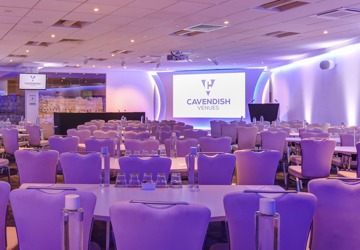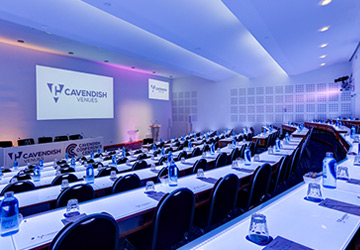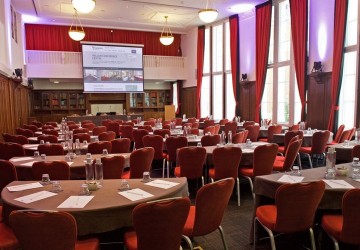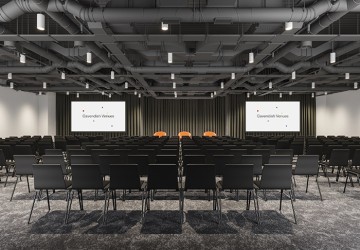How to ensure the success of your meeting
In the world of meetings and event management, the idea of creating memorable “experiences” is becoming an ever more important element. In fact, in a recent survey for the 2018 Meeting Room of the Future Report, IACC found that 57% (up from 56% last year) of venue operators said an important part of their role is to provide “experience creation.” And they expect this to become an even more important trend in the next five years.
Experience creation may incorporate factors ranging from the types activities planned, food and beverage served and layout of the venue to the style of presentations, décor and entire format of the event. The ways a venue is used and how the various aspects of the facilities are incorporated can play a significant role in the overall experience – as can the style of presentations, length of them or transitions between sessions.
Venue operators are being asked for experience creation and in many cases, they are responding with higher levels of existing services,” said Sarah Weller of Steelcase. In some cases this means bringing in specialists in experience creation or design. “Spatial experience design consultants have the ability to partner with the meeting planner and the venue to shift the meeting to a true experience for participants,” she added. But when it comes to measuring the impact of a meeting experience, what matters? If experience creation is the buzzword, how do we know if we succeeded? The key of course, is to start with a clear goal so outcomes can be benchmarked.
You must start by asking, what is the objective of the meeting?” said Mike Van Der Vijver of MindMeeting. “When people leave the event and go back to their jobs or regular lives, what do you want them to do differently?”
Setting the objectives
When the objective of an event or meeting is to increase sales, measuring the ROI may be straight-forward. You simply measure sales after the event. But what about when the goal is education, or to change a behaviour? What level of change or participation is considered an acceptable outcome? “People don’t change their minds – or their actions – easily,” said Van Der Vijver. “So you might have to change yours. Really think about how you structure the meeting and what you want attendees to get out of it. Facts won’t make people change their approach. They need to experience something on an emotional or physical level that creates a need to change.” In fact, Mark Levine, a Psychology Today writer, says that emotions drive 80% of the choices people make, while practicality and objectivity only represent about 20% of decision-making. If you want an action performed, such using a new software program or app, implementing a new strategy or joining a discussion group, make it possible for the attendees to do it right at the meeting rather than waiting until later. Or provide some other incentive, or a reward for follow-through. Consider whether you can opt people in instead of out. A compelling emotional story can help motivate people to take action, as well. For example, as a keynote speaker at large events Scott Harrison, founder of Charity Water, shows a moving video and asks people to log onto their phones right then and there and make a pledge to donate their birthday or anniversary to Charity Water. It’s a very effective combination: emotional appeal and immediate action. For meeting planners and venue operators, that means changing the structure of meetings to incorporation more sensory, emotional, or physical elements into the meeting to drive learning and decision-making. “Many people learn better by doing, or with a physical interaction – some sort of participation – than simply sitting and listening in a lecture hall,” said Dianne Devitt, Founder of The DND Group, Inc and Adjunct Professor at NYU. Including elements to encourage delegate interaction improves retention, engagement and event success.
Planning the elements
Part of being able to measure the outcome of a meeting is to make sure you have the right elements in place to allow measuring later. For example, if a successful measure of a networking meeting is how many meaningful conversations they have, you need to ensure the meeting is set up to allow those elements.
- Ensure there are ample and efficient opportunities for attendees to mix and mingle – many short breaks and networking opportunities instead of only one.
- Create conversation starters or moments in the meeting that require guests to speak with each other.
- Include icebreakers that warm up the attendees by sharing a story, idea or participating in a group activity.
- Introduce a game such as “catching thumbs” (turn to the person next to you, interlock hands and try to capture the other’s thumb under yours) that requires interaction.
“Meetings often have two objectives – a training or business objective that is always stated up-front, and an interpersonal objective that is normally more tacit than overt, but just as important,” said a Delphine Boisard at Châteauform’ Group. Designing spaces to accommodate both needs can be challenging, but very effective when done right. “Everything from the layout of our houses, to the leisure activities on offer and our traditions – have been conceived with the idea of bringing people together and fostering collaboration and team spirit.” The Châteauform’ venues have even removed televisions and radios from the guest rooms to encourage the sort of interaction that occurs when teams play a board game, sing karaoke or watch a program together in a common room. “Designing the spaces so they encourage guests to interact, or play games together instead of retreating to separate spaces, can help planners achieve their goals of fostering a closer connection between the delegates” said Delphine.
Creating memorable moments
“Part of creating experiences that deliver good outcomes is affecting a change or creating a positive memory,” said Van Der Vijver. “Senses impact memory.” Do a sensory audit of the environment. Consider what factors may affect the outcomes and look for ways to mitigate these. For example, is the lighting too low for attendees to prepare ideas and present back, background noise to loud for meaningful conversations, is street noise interfering with concentration? Consider how the length of sessions might impact attention spans. Common estimates for sustained attention in adults is around 20 minutes. In longer sessions, many educators say that introducing an interactive or stimulating “hands-on” element at least every 15-20 minutes provides the best learning outcomes. Venues with a flexible layout that can be changed during the meeting provide more opportunities to create the types of memorable moments and learning opportunities needed. “I think that a modern design, combined with a world class hosting is a great factor to succeed,” said Lotta Boman CEO of Sigtunahöjden Hotel & Conference Center. “We have generous use of green in our lounge/bar-restaurant area that creates a warm feeling and adds energy. In meeting rooms, however, we have softer, calm hues like oak, grey, black and white, which allows companies to add their own style with rollups and accessories.”
Consider the sensory impacts
In retail stores, scents are often used to elicit a specific emotion to get buyers into the right mind-set to take action. A scent that triggers a memory can remove rational barriers. For example, vanilla is thought to stimulate sales because we associate the scent with mother’s milk. The scent of coffee in a meeting can make people feel more stimulated. Cavendish venues strive to combine multiple elements to optimise the learning environment, from bio-adaptive lighting specifically designed to enhance the leaning experience, to frequently changing art works curated to offer conversation points for organizers and delegates to award winning catering. .” Certain essentials oils may also have helpful properties that stimulate mental energy or alertness. The scent of rosemary or essential oils like peppermint may help boost memory and attention, according to a study by the International Journal of Neuroscience. “When it comes to scents, it doesn’t have to be complicated,” said Boman. “Freshly baked bread, clean toilets and floors, an fresh flower helps a lot. If you have a spa department you should of course feel the chosen brand for the treatments – and we all love that spa scent don’t we?” Sounds may also help create recognition, set a mood or stimulate a transition or repetition of a meeting element. Consider how the roaring lion of Metro Goldwyn Mayer Studios signals the beginning of the movie, or the sad trombone (“wah wah”) signals a “wrong answer” or pitiful situation on a game show or sitcom. Playing classical music can set one tone while pop music sets another. “Repeating a specific musical interlude can signal to guests when it’s time to change rooms, start the next session, or introduce a speaker,” said Devitt. “Designing a meeting with specific auditory cues may help the audience remember the meeting transitions or elements later.” Artwork can also be used for more than decoration. “Distributing interesting or visually arresting artwork, or having an unusual piece placed in a conversation area, can give delegates something to talk about during networking portions of the event,” said Simpson. “It helps to create a starting point for conversations.”
Introducing elements during the event
“Measuring outcomes is not the same as measuring satisfaction,” said Van Der Vijver. “Knowing whether a speaker was good or not provides feedback for them and for future planning, but it doesn’t tell you anything about whether the meeting met its goals. You can ask people of their intentions to take action, but the true insight comes in measuring if they actually do.” Designing a meeting with impact and memorable moments often means doing something different. “Exciting and engaging meetings often have an unexpected element,” said Devitt. “This could be the design of the room, the type of speaker or the format used, the food, or activities the attendees are asked to participate in.” Devitt creates workshops that incorporate the idea of “Permission to play” using creative exercises and visual aids to spark the creativity. These include four sensory elements (Hear, See, Touch, Engage), which include listening to a business strategy, seeing specific tactics and examples, touching creative elements and interacting with exercises. Don’t leave parts of the meeting unplanned, she warns. “Unstructured elements of a meeting are something of a trend right now,” Devitt said. “But these can lose the focus of the meeting. If you have goals or outcomes to achieve, you need to keep every element of the meeting focused on those goals.” The worst offense, she said, is to not understand your audience. Make sure you know who is attending the meeting, and what their needs and expectations are. “I once had a meeting attended by sheiks, and we had to make sure the kitchen didn’t cook any pork products. No bacon that morning. If they even smelled it, they threatened to walk out.” “Successful venues help planners achieve great outcomes aren’t just selling square feet,” said Van Der Vijver. “They are working closely with the planners to understand the flexible needs of a meeting space and providing opportunities to produce engagement and memorable moments.” Follow-up after the event
To really understand the ROI of a meeting, you have to measure outcomes after the event. Did people actually follow-up with the new program? Who implemented the training? How many signed up on the website? Did participation or sales increase? “You may need to do a follow-up survey 3 or 6 months later to ask if the meeting had an impact. Find out if any changes were made and what impact the meeting had on that,” said Van Der Vijver. Getting actual data is important to measuring the result. “We can do a lot better job in the types of questions we ask in follow-up surveys to really understand the impact,” added Devitt. “Be very specific about actions taken not just a general How did you like it? Ask: What were your expectations? What did you learn? Did you implement it?” You might consider building a reason for the attendees to report back to you into the meeting program. Create a way for them to present results, maybe via a website page, part of a contest to gauge change (prize for the winner) or the chance to present their case study at a future meeting.
The bottom line
Successful meetings are ones designed with smart objectives in mind from the beginning. Be careful not to confuse attendance goals with outcomes. Design your meeting to address the objectives, whether that means a learning outcome, a networking outcome, or just creating a memorable event with happy attendees who share the experience with others later.
Thank you to the IACC for the vast majority of this blog piece
Bookings & Enquiries
Whether you need help planning your event, have a question about one of our venues or want to make a booking, our friendly Venues Team are here to help.
+44 (0)20 7706 7700
Why Cavendish?
At Cavendish Venues we are committed to exceeding your expectations, and with over 93% repeat business we know we're doing something right!



